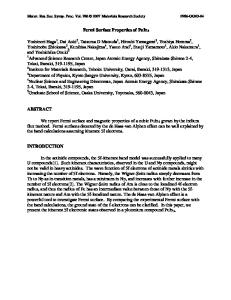Fermi Surfaces of Composite Fermions
- PDF / 2,600,857 Bytes
- 16 Pages / 439.37 x 666.142 pts Page_size
- 89 Downloads / 396 Views
Fermi Surfaces of Composite Fermions R. N. Bhatt1 · Matteo Ippoliti2 Received: 13 July 2019 / Accepted: 2 February 2020 © Springer Science+Business Media, LLC, part of Springer Nature 2020
Abstract The fractional quantum Hall (FQH) effect was discovered in two-dimensional electron systems subject to a large perpendicular magnetic field nearly four decades ago. It helped launch the field of topological phases, and in addition, because of the quenching of the kinetic energy, gave new meaning to the phrase “correlated matter.” Most FQH phases are gapped like insulators and superconductors; however, a small subset with even denominator fractional fillings 𝜈 of the Landau level, typified by 𝜈 = 1∕2 , is found to be gapless, with a Fermi surface akin to metals. We discuss our results, obtained numerically using the infinite density matrix renormalization group scheme, on the effect of non-isotropic distortions with discrete N-fold rotational symmetry of the Fermi surface at zero magnetic field on the Fermi surface of the correlated 𝜈 = 1∕2 state. We find that while the response for N = 2 (elliptical) distortions is significant (and in agreement with experimental observations with no adjustable parameters), it decreases very rapidly as N is increased. Other anomalies, like resilience to breaking the Fermi surface into disjoint pieces, are also found. This highlights the difference between Fermi surfaces formed from the kinetic energy, and those formed of purely potential energy terms in the Hamiltonian. Keywords Fractional quantum Hall effect · Two-dimensional electron gas · Fermi surface
1 Introduction Following the experimental discovery [1] of the FQH effect at an electron density corresponding to a filling of 𝜈 = 1∕3 in the lowest Landau level, Laughlin [2] provided an understanding of the existence of FQH liquid phases at other inverse odd-integer fillings, e.g., 1/5, 1/7 etc. Theoretical work [3–5] categorized the large number of FQH phases seen in subsequent experiments [6, 7] into a hierarchy of * R. N. Bhatt [email protected] 1
Department of Electrical Engineering, Princeton University, Princeton, NJ 08544, USA
2
Department of Physics, Princeton University, Princeton, NJ 08544, USA
13
Vol.:(0123456789)
Journal of Low Temperature Physics
fractions. The most widely used scheme today [5] relies on the concept of “composite fermions” (CFs), i.e., electrons bound to an even number of flux quanta or vortices. A mean-field description of the electron system at 𝜈 = 1∕2 in terms of composite fermions made up of electrons bound to two flux quanta gives rise to a Fermi liquid-like state [8] known as the composite Fermi liquid (CFL). This result has been verified in a number of experiments including direct determination of the Fermi surface [9]. Nevertheless, it is a very counterintuitive result in terms of the original electron system for which the kinetic energy is totally quenched by Landau quantization, and the Hamiltonian consists of purely potential terms! For systems possessing continuous rotati
Data Loading...











